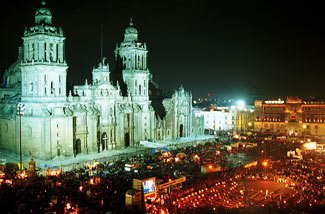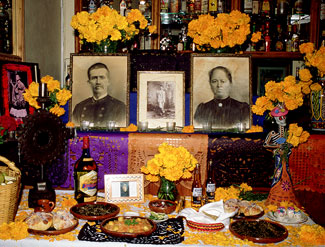 Cathedral on the Zocalo, Mexico City Cathedral on the Zocalo, Mexico City |
 |
 hick with the pungent smell of burning copal, there was an incense-laden air of anticipation in the small, stucco-walled churchyard of Mixquic. Since dusk, the townspeople of the Mexican village had been arriving in the candle-lit cemetery to gather around family gravesites and await the midnight arrival of the spirits of their departed loved ones...
Dia de los Muertos (Day of the Dead) is the most traditional of Mexican holidays. Based on pre-Hispanic roots and Christian customs, it is as much celebratory as outsiders might think it is macabre. For days leading up to the holiday, marketplaces and flower stalls are filled with the symbols of the occasion - pan de muerto, candy calaveras and cempasuchiles.
|
| |
The Mexican people are fervent in their belief that death is not the end of life, but a transition to another worldly existence. On November 1-2, coinciding with the Catholic holy days of All Saints Day and All Souls Day, they welcome the souls of deceased family members and friends who return to earth to commune with the living. To prepare the way, time-honored rituals are performed in homes, public spaces and, in the most memorable of places, cemeteries where all-night vigils are held.
Ofrendas (altars) are mounted in homes and businesses and adorned with the bright orange cempasuchiles (marigolds) and colorfully decorated paper. Traditional foods, like the special loaves of sugar-decorated bread and the candy skulls and skeletons, are placed atop the altars, as are the favorite food and drink of the deceased.
|
 |

Ofrenda, Tequilaria |
|
| |

Haunted Bride
|
 |
"If they had a liking for cerveza (beer) and cigars, those, too, will have an appropriate spot," said Cristine Barajas of the Department of Urban Culture in Mexico City. The most revered place on the ofrenda, however, is reserved for photographs of loved ones - mothers, fathers, grandparents and children - whose souls will be returning over the two-day holiday.
Early in the day on November 1, family members visit the cemeteries to prepare the gravesites for the coming nights' festivities. Earthen graves are rebuilt, new wooden crosses are erected, and tombs are swept and embellished with flowers and colorful coronas (wreaths). Just after midnight, the first souls to arrive are those of the Angelitos (deceased children). Led by a path strewn with marigold petals, the little angels are welcomed in their homes and at their graves with offerings of white flowers, sugar paste sweets in the shapes of animals and, in some places, toys made of clay.
..As the night grew colder in the graveyard of Mixquic, the festive atmosphere grew warmer with the playing of lively music by roving minstrels and the passing of tequila among men who toasted to the memory of old friends. Elderly women, wrapped in colorful, hand-knitted shawls, kept watch at the graves and a keen eye on children playing with skeleton figures. Lit by the glow of thousands of candles, the way for the departed ones was brightly illuminated.
|
Outside the walls of the churchyard, the atmosphere was fiesta-like. The narrow, cobbled road leading up to the cemetery's arched gateway was strung with bare bulb lights and lined with vendors selling food and drinks; families feasted on tamales and candied pumpkin; and children hawked colorful, glow-lite 'candlesticks' within the tide of people that slowly moved to the cemetery.
By midnight, prayers and quiet sobbing around the graves mingled with the uplifting sound of guitars and accordion music as the townspeople of Mixquic welcomed their departed loved ones with offerings, and then, with the tolling of church bells, sent them back from whence they came. |
 |

Decorated Skulls |
|

 Cathedral on the Zocalo, Mexico City
Cathedral on the Zocalo, Mexico City